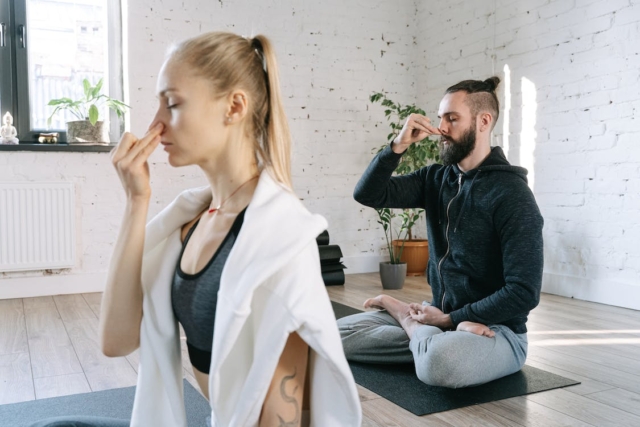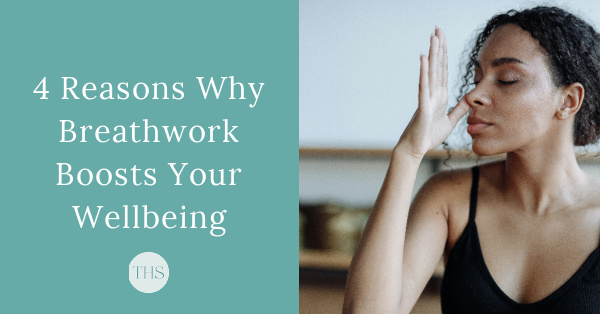8 Pillars of Wellness to Strengthen Your Holistic Health

Breathwork training – also known as Pranayama breathing – is a mindfulness tool where you simply focus your attention on your breath, using various breathing techniques.
Through breathwork training, we can learn to take a moment outside of the usual busyness and chaos of the mind and create a sense of calm. It can allow us to be more present and aware, helping us to better recognise and appreciate all the wonderful things we have in our lives. Through this, we can work to decrease stress and improve our emotional wellbeing. During sessions it’s very normal to feel a huge emotional release. Being present and acknowledging the way you feel, without judgement, just awareness, can be a powerful thing indeed, especially if you’re dealing with something as huge as chronic illness.
Taking care of your emotional, physical, and mental well being through fitness, nutrition and practices such as this can be the difference between simply surviving and actually thriving. It’s all well and good having my (slightly biased) self bang on about how amazing breathwork training practice is, but let’s have a look at the science behind it and how using this practice can boost your wellbeing.

A systematic review published by Frontiers in Human Neuroscience shows that slow breathing techniques have the most notable effects on the autonomic and central nervous systems, as well as on our psychological status. Slow breathwork training techniques can increase our Heart Rate Variability (HRV), which often means that your relaxation response is functioning, according to Healthline. They also mention that an increased HRV usually indicates that your autonomic nervous system is balanced, and so you can find it easier to adapt to internal and external stressors more effectively. Consequently, responding to stress becomes easier, which is always welcome!
Further findings from the systematic review show that other changes to the Central and Autonomic nervous systems can increase comfort, relaxation, vigor and alertness, and reduce symptoms of anxiety, depression, anger, and confusion. Personally, that all sounds more than ok! A higher HRV also has strong links to both mental and physical health overall, including physical and cognitive performance – so that’s basically how ‘on it’ you feel during the day – if you struggle with alertness, spatial awareness or focus, breathwork training may be well worth a try. In the conclusions by Andrea Zaccaro et al. they mention finding evidence of links between slow breathing techniques, emotional control and psychological well-being. This basically means you can feel a bit more in control of how you feel day to day, which can be absolutely paramount when facing chronic illness.
A review conducted by Katherine Ka-Yin Yau and Alice Yuen Loke of 13 studies, resulted in findings that using deep breathing techniques may result in a decrease in blood pressure in hypertensive or prehypertensive individuals (those with high blood pressure). High blood pressure over an extended period of time can increase your risk of many serious health conditions, such as heart disease, arterial disease and kidney failure. You may also be more at risk of developing high blood pressure due to other chronic health conditions and/or maintaining high stress levels over extended periods of time as well. So, using breathwork training to decrease your stress and blood pressure work together really well.
A review conducted by Thayla A Santino et al. which evaluated 2880 participants across 22 studies, showed that breathwork training may have beneficial outcomes on quality of life, symptoms of hyperventilation and lung function. The evidence is not conclusive and more research is certainly needed, however it’s promising. Being able to manage any chronic condition, even in a small way using alternative therapies is always a win.

If one of the reasons mentioned above has piqued your interest and you’d like to give this beautiful practice a go, you could start with simple box breathing. This means you inhale, hold, exhale, then hold for the same amount of time. You can start with 4 seconds and increase to 6 or even 8 once you feel ready.
There are a few other breathing techniques here that you could then try, and each has the benefits of the technique included, so you can decide which might be most useful for each time you practise. There are also online or in person group sessions that you can often find in your local area, led by instructors which can evoke more powerful responses. You may find that practising this way is more effective, but you may find that practising alone works better for you instead – one size does not fit all here, so see what works for you.
Generally, to sit and focus your awareness on your breath using a specific breathing technique, you could set a timer for ten minutes to start with. You can then work your way up to an hour when you feel you can sit and keep your attention on your breath for that long.
It’s ok if your attention starts to wander, simply place your thoughts to one side and bring your attention back, you can’t expect to excel at this from the very start, it does take time. It may help to picture that you’re in your own personal bubble, away from the busyness of the outside world. When thoughts and noise creep back in, picture placing them just outside of your bubble. There’s no need to try and get rid of them completely, they are still your thoughts, but you can deal with them later. This time is for you.
Warning: Please check with your GP before beginning breathwork training as there are some conditions that require a more careful approach. For example, you should avoid strong breathing practices such as strong yogic breathing, Bhastrika or ChidShakti pranayama breathing if you are feeling anxious, if you have heart, lung conditions, epilepsy or if you are pregnant. So choose a calm, slow breathing technique instead. You should also avoid holding your breath, and instead perform a constant flow of inhale/exhale.

It’s important to note that you don’t necessarily need to conduct full breathwork sessions. At any moment during the day, particularly if things are getting overwhelming, you can take a few moments for yourself.
Simply focus on your inhale, then exhale, as if it’s a conscious process. Think of it like a wave coming in to shore and then rolling back out in a continuous, fluid movement. I often actually picture the ocean and match my breath to a wave coming in and going back out. Even just stopping and taking a few breaths like this every now and then during the day, can help to ground you and slow/calm the mind.
For more breathing exercises, check out the 4-7-8 breathing technique and how to practice alternative nostril breathing.
Author bio: Ray is a Manchester-based queer personal trainer and nutrition coach. She provides in-person training at her own private studio, as well as on-line nutrition and lifestyle coaching. She also offers breathwork training sessions to clients and organises excursions to participate in activities like yoga, ice baths and other practices that promote mindfulness. Her passion is overall mental and physical health to strive for happier, more fulfilled lives. You can find out more about her via Instagram.